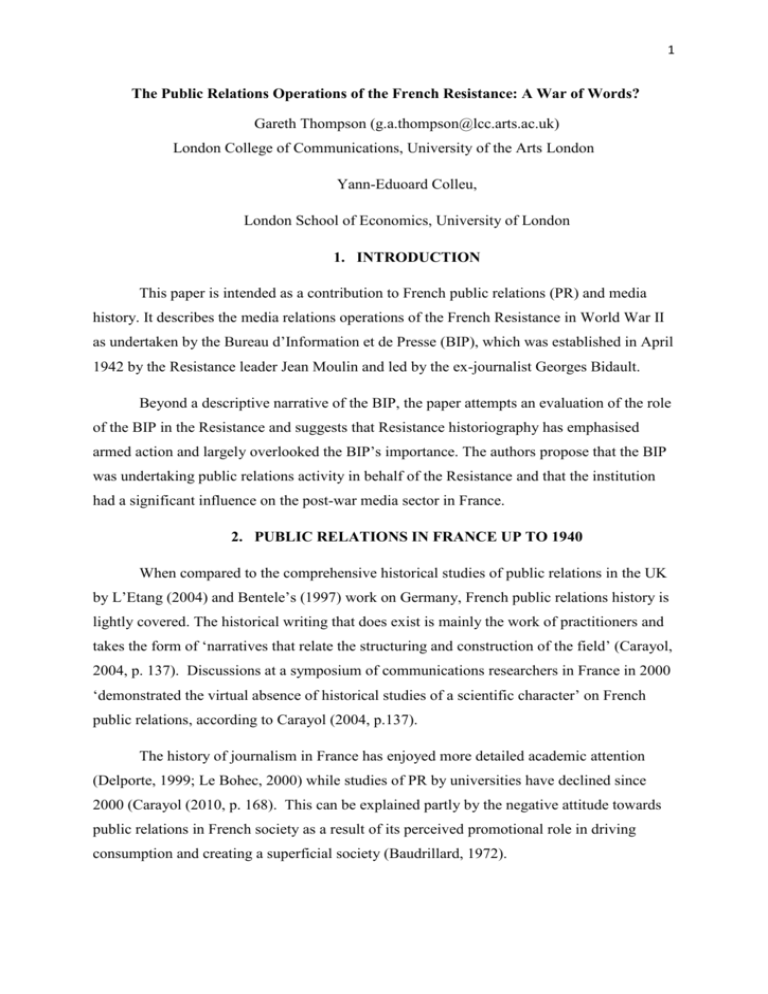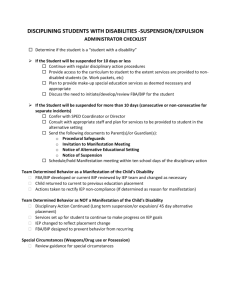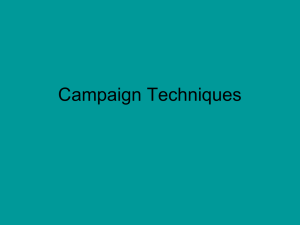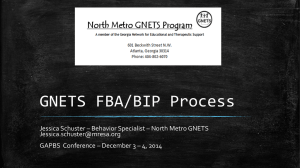Untitled - UAL Research Online - University of the Arts London
advertisement

1 The Public Relations Operations of the French Resistance: A War of Words? Gareth Thompson (g.a.thompson@lcc.arts.ac.uk) London College of Communications, University of the Arts London Yann-Eduoard Colleu, London School of Economics, University of London 1. INTRODUCTION This paper is intended as a contribution to French public relations (PR) and media history. It describes the media relations operations of the French Resistance in World War II as undertaken by the Bureau d’Information et de Presse (BIP), which was established in April 1942 by the Resistance leader Jean Moulin and led by the ex-journalist Georges Bidault. Beyond a descriptive narrative of the BIP, the paper attempts an evaluation of the role of the BIP in the Resistance and suggests that Resistance historiography has emphasised armed action and largely overlooked the BIP’s importance. The authors propose that the BIP was undertaking public relations activity in behalf of the Resistance and that the institution had a significant influence on the post-war media sector in France. 2. PUBLIC RELATIONS IN FRANCE UP TO 1940 When compared to the comprehensive historical studies of public relations in the UK by L’Etang (2004) and Bentele’s (1997) work on Germany, French public relations history is lightly covered. The historical writing that does exist is mainly the work of practitioners and takes the form of ‘narratives that relate the structuring and construction of the field’ (Carayol, 2004, p. 137). Discussions at a symposium of communications researchers in France in 2000 ‘demonstrated the virtual absence of historical studies of a scientific character’ on French public relations, according to Carayol (2004, p.137). The history of journalism in France has enjoyed more detailed academic attention (Delporte, 1999; Le Bohec, 2000) while studies of PR by universities have declined since 2000 (Carayol (2010, p. 168). This can be explained partly by the negative attitude towards public relations in French society as a result of its perceived promotional role in driving consumption and creating a superficial society (Baudrillard, 1972). 2 This promotional dimension – and related unease – is present in contemporary French dictionary definitions of public relations and in a more recent book on French public relations (Chouchan and Flahault, 2005, p.5), where the verb promouvoir, or to promote is used to define public relations. 3. HISTORIOGRAPHY OF THE FRENCH RESISTANCE The history of the resistance has been comprehensively documented with over 3,000 books published in French alone, with numerous academic papers and many museums dedicated to the subject. Resistance history was being written even before all German soldiers had left France, following the decision by De Gaulle’s government to establish the Comite d’histoire de la Deuxieme Guerre mondiale, headed by the historian, Henri Michel (Michel, 1981, p.2). Michel’s committee co-ordinated regional correspondents who collected information on the Resistance in their area, drawing on more than 2,000 interviews with activists. A political dimension to resistance history emerged in memoirs by leaders who presented differing pictures depending on whether they had been based in London or France. The head of the Free French intelligence services in London, A. Dewavrin (codenamed Passy), who worked with Bidault and Moulin, records with some detachment that the French Resistance had ‘brave thoughts and exalted imaginations which translated into disorganised actions without real effectiveness’ (Dewavrin, 1948, p 105). Some elements of the role of media in the resistance have been addressed by Bellanger (1961) and Wieviorka (1996) with their work on the clandestine press, which mentions but does not focus on the BIP. The social history and role of groups of workers – such as journalists who wrote for the BIP and the railway workers who distributed their material and the clandestine newspapers - has been largely overlooked while the armed resistance has been eulogised. Beyond France, military historians (including Roberts, 2009 and Beevor, 2009) have assessed the impact of the resistance in purely military terms. In a 700-page history of World War II, Roberts devotes only nine pages to the French resistance, pointing out that during the first eighteen months of the Occupation, no Germans were deliberately killed by the French in Paris and only one demonstration was held (2009, p.79). According to Beevor (2009, 3 p.45) the main contribution of the resistance to the 1944 allied invasion of France ‘lay not in guerrilla action but in intelligence and sabotage.’ 4. MEDIA CONTEXT 4.1. The Clandestine Press Despite a lack of arms, the sense of a need to do something was common among early resisters. The Combat resistant, Jacques Poirier, recalls in an interview (Poirier, 1988) that ‘I felt strongly that young people like me should do something but it was hard to know what to do.’ Instead of guerrilla operations, the media and the printed word played a crucial role in the early stages: ‘Resistance chose to make the first battle it fought a battle of language. Most of the names of the movements…were also the names of underground journals and rather than being simply organs of those movements, the journals were at the start, and in a very real sense, the movements themselves,’ (Ousby p.219) Parsimonious assessments of the value of armed resistance in military history while at the same time ignoring media operations represent ‘a fundamental misrecognition of the value to be accorded to the ideological and the discursive at this time….it is difficult to see how, without public expression, there could have been a resistance’ (Atack 1989 p. 18) The operational scope and the social composition of the resistance also changed over time as new tasks arose but in 1940-1942, it required people ‘to write for newspapers and produce them.’ (Jackson, 2001, p.478). The lack of training and arms ‘made early resistance concentrate on publishing journals’ (Ousby,1999, p.241). This pattern of resistance movements focussing on media and communications followed the same pattern throughout France. ‘A handful of friends got together, decided they had to “do something” and then eventually found a way of producing stickers, leaflets or a newspaper,’ (Cobb, 2009, p.61 In a chapter of his resistance history describing the different types of struggle (Les Formes de Lutte) Muracciolle writes that the clandestine press and propaganda were for a long time the main force or arm of the resistance (1993, p.75). The growth of the clandestine press was entwined with resistance from its inception. There were clandestine papers without movements and movements without papers but movements without papers were rare. Most resistance movements were known by the name 4 of the publications they produced and according to Kuhn (1995, p.23) it is no coincidence that the main resistance movements in the southern zone were known by the name of their successful newspapers; Combat, Franc-Tireur and Liberation (sud), while in the occupied zone the same was true of the Paris-based movements, Liberation (nord) and Defense de la France. As movements developed, so did the diversity and distribution of the clandestine press. Media was such a crucial component of resistance in the years after the 1940 occupation that some historians used the number of publications and extent of their distribution as a proxy measure for the impact of the resistance overall. ‘If it is difficult to estimate the size of the Resistance at the end of 1942, it is even harder to estimate its impact on the population. One measure of visibility is the underground press,’ (Jackson, 2001, p.438). Resistance by media was important to movements beyond mainland France. In the densely policed Channel Islands on Jersey, a left-wing resistance movement formed by Norman Le Brocq put much of its energy into political meetings and the publication of leaflets (Le Brocq, 1997). Some of the publications were distributed in the Organisation Todt camps (for forced workers) and this publishing of resistance messages was seen by Le Brocq (IWM interview) as critical in channelling dissent on Jersey where the ratio of islanders to Germans (there were more Germans per square mile in Jersey than in Germany) led many to conclude that ‘the futility of resistance under these conditions was obvious’ (Sanders, 2005, p.104). The smaller island of Guernsey also had an active clandestine press. The elderly World War One invalid, L.E. Bertrand listened illegally to BBC news broadcasts and then wrote up stories in order to spread the news (Bertrand, 1945) in the Guernsey Active Secret Press. The journalist Frank Falla produced the Guernsey Underground News Service until he was denounced and jailed in Germany in 1944 (Falla,1994). 4.2. Press agencies, radio and the rhetoric of resistance In 1939, the print media in France was vibrant, with 31 daily newspapers published in Paris and 175 in the regions (Albert, 1990, p.32). This widespread coverage of the French population made the media an important channel for public relations activity. 5 For some of their content at least, papers relied on the Agence Havas news agency. At the time, the Havas group combined an advertising business, Havas Publicite, with the country’s largest news agency. This co-mingling of advertising with a news agency in France was unusual compared to the USA and UK, for example, which both had not-forprofit agencies founded in the 19th century and were co-operatively owned by newspaper owners (Associated Press in the USA and Press Association in the UK) as well as privately operated news agencies (United Press International and Dow Jones in USA and Reuters in the UK). After the fall of France in June 1940, the Agence Havas news agency was taken over and renamed L’Office Francais d’Information (French Information Office) or OFI. The Havas advertising business retained the Havas name, operated separately during the war and still exists today as an owner of both advertising and public relations businesses. The break-up was achieved by a partial nationalisation which led to the information branch coming under control of the occupying forces (Palmer, 1976, p.19). According to the memoir of a director of the Havas News agency, (Polonski,1946, p.57-58) the Vichy government made it clear that the previously private agency could not remain independent and must be integrated, along with radio, into a State-operated media organisation charged with directing opinion under the control of the authorities. The OFI proactively issued media guidance notes (notes d’orientation) on how to report events (Palmer, 1976, p19) in order to control the news agenda. In the southern zone, the Vichy government of Marshall Petain combined its media work with that of the Germans, resulting in a vast scale of propaganda. The Germans alone published 17 million brochures, 100 million leaflets and 400,000 copies of 23 different posters in the Southern Zone alone over a two year period from 1941 (Burrin, 1997, p187). While acknowledging that any media relations effort on behalf of Resistance views was practically impossible to undertake, the disparate body that made up the early Resistance recognised the importance of ‘winning the battle for public opinion…..the Occupation was and remained a war of words and images long before armed conflict restarted’ (Atack, 1989 p.3). For Ousby (1999, p.218) the strict control of the press by the occupying forces was a manifestation of ‘the importance of the terrain being contested, of words themselves……in its concern with language the underground press created a rhetoric of resistance to counter the rhetoric of the Reich and Vichy.’ 6 The use of media relations techniques was at the heart of communicating this rhetoric of resistance: ‘It became clear that resistance would not develop its full potential strength until it became the expression of the will of the majority of the subject peoples To convince them, a vast propaganda campaign was instituted……They used two main weapons: radio broadcasts outside occupied Europe and the clandestine press inside,’ (Michel, 1972, p.8687) Vladimir Trouplin, director of the Musee de L’Ordre de la Liberation in Paris suggests that around 300,000 people listened to De Gaulle’s first broadcast from London in 1941 (Eagle Media, 2003). Due partly to the promotion of the broadcasts in the clandestine press, by 1942, Vichy estimates suggested ten times that figure were tuning in. Radio was favoured by De Gaulle because it offered ‘a unity of control’ compared to the diverse underground press (Wievorka, 1996, p.128). Bidault (1967, p.21) took the view that ‘British radio, more than anything else, helped to establish de Gaulle’s name. The BBC literally made de Gaulle.’ Some bitterness comes through in his memoir, when he observes that once the English discovered how inflexible he was, they probably regretted all the publicity they had given to the Free French leader. 5. ESTABLISHMENT OF THE BIP: THE VOICE OF THE RESISTANCE Jean Moulin, prefect of Chartres in 1940, resisted the Nazi invasion and attempted suicide rather than sign a false document by his German captors. He escaped to begin life as a resistance leader and in October 1941, he flew from Portugal to London, one of only six people to be bought out of France by the Royal Air Force (RAF) from 1940-1941 (Cobb, 2009, p.88). After meeting with General De Gaulle, leader of the Free French - as well as representatives from the UK’s MI6 intelligence service and the Special Operations Executive (SOE) – he returned by parachute drop in January 1942 as the delegate of General de Gaulle to Nazi-occupied France under the codename Rex. On arrival, he founded the Conseil National de Resistance (CNR), or National Resistance Council which aimed to unify the different resistance groups operating in the northern and southern zones and co-ordinate their activities in preparation for an allied invasion. The priority Moulin placed on media relations drove his first action on returning from London, which was to establish what he called a ‘voice of the resistance’ linked to but 7 separate from the Free French and the BBC, (Clinton (2002, p131). Jackson (2001, p.434) describes BIP as the ‘Press and Information Bureau, a sort of Resistance press service….to publicise themes of Free French propaganda and pass on suggestions for propaganda to London.’ Both definitions have a public relations dimension with BIP acting as a mouthpiece for the resistance in general and the CNR specifically. The creation of the BIP was announced in a 28 April 1942 telegram from Jean Moulin to the London-based Bureau Central de Renseignements et d'Action (BCRA) intelligence service. The text of the original telegram is held in the papers of Moulin’s radio operator and secretary, Daniel Cordier in Centre National de Jean Moulin in Bordeaux and is cited in his memoirs (Cordier, 1999, p.308). ‘28th April 1942, Telegram N°6, sent from London: Jean Moulin: Missions: 1/ Spread information and propaganda from London. 2/ Distribute the propaganda material from the FFL using our networks 3/ Pass on information which may be of interest. 4/ Prepare articles and documents to be published in the press (FFL, British, American, and neutral). I have obtained the services of G. Bidault, former editor in chief at l’Aube, to manage the service with his team.’ Kedward (1978, p.244) views the establishment of the BIP as a reflection of the increased professionalism of the resistance press in the years 1940-1942 as well fulfilling the important role of linking the publications in both zones: ‘In organisational terms, it (formation of BIP) was a recognition of the vital significance of journalism and communication in the growth of the resistance and a rationalisation of the underground press as a sector of activity on its own, manned by professionals.’ Bidault chose to locate his headquarters in Lyons. As the press capital of the Unoccupied Zone, the city was attractive as the headquarters for a media relations operation as it boasted ‘a high concentration of journalists, printers and typesetters as well as facilities of the production of newspapers.’(Jackson, 2001, p.438). 8 Despite this political communications dimension, the BIP did not run a single minded propaganda operation which favoured one political point of view. Instead, the leadership recognised a need to find a balance across a political spectrum which ranged from the communists on the left (typified by the Front Nationale group) to the fascist groups on the right (such as L’Action Francaise). Henri Frenay, the leader of the Combat movement stressed the need for a middle way which accommodated diversity and promoted balance: ‘We will no more tolerate communist interference in our country than we will tolerate Nazi interference,’ (Cordier, 1999, p.116). Moulin’s establishment of the BIP and other joint services to support the resistance movements is seen by Cobb (2009, p.128) as his ‘main achievement.’ These central services were designed to provide a new ‘moral and material unity’ and he followed up the establishment of the BIP in April 1942 with the CGE (Comité Général d’Études, July 1942 (Cordier, 1999, p.306). By the end of the year, these were supplemented by two other technical services, for Wireless Transmissions, and the SOAM (Aerial and naval operations) to support transport of people and supplies. (Cordier, D./Centre National de Jean Moulin, Bordeaux) 9 6. DEFINITIONS AND OPERATIONS: WHAT WAS THE BIP AND WHAT DID IT DO? Alongside definition of terms, the writers have examined evidence from the BIP’s operations as a basis for taking a view on whether the organisation’s work could be classed as public relations activity. Regarding the possible definitions and translations of BIP, the words chosen by Bidault and Moulin appear deliberate with Bureau d' Information et de Presse sound very official in the French. The use of Bureau denotes a branch of government in France and seems to have been used to inflate the importance of the newly formed institution. The words bureau and information place the BIP beyond just a traditional press agency (e.g. Agence France Presse) and for this reason we favour the term office rather than agency. The Vichy press relations operation had implemented a similar change of language with the Agence Havas news agency was renamed L’Office Francais d’Information when nationalised. The use of the word information is also important and the suggestion is that it refers to information and data gathering (as well as distribution) rather than news (les informations in French). A combination of intelligence gathering from media sources (the underground press), news distribution and a press office is an appropriate translation of BIP and an accurate reflection of its role as an interface between the coalitions of resistance organisations (such as the CNR) and the undercover press in France and other media in the UK and USA and beyond. The intelligence gathering dimension of the BIP’s work may seem an unusual combination with media work but gathering intelligence from the media was widespread practice throughout the World War II. Tombs (2002, p.104) describes newspapers as a down to earth and yet neglected source which accounted for 60% of the economic intelligence gathered on Germany. The definition of terms which Tombs (2002, p.105) uses to define the way Britain’s Foreign Research Press Service used newspapers to gather intelligence and to describe the a scope of operations which included intelligence material being ‘gathered, analysed and diffused’ mirrors closely the language used by Moulin to define the work of the BIP. French historians use different language to describe the specifics of the work of BIP. Murraciole (1993, p.77). describes how from 1942, Bidault’s BIP ‘diffusa l’information de 10 Londres’ (disseminated information from London) via the Bulletin de la France Combattante and the Bulletin d’informations generals. These bulletins were partly media background documents and partly news releases put together by trained journalists The tone of the material they produced and the language they used varied from balanced articles such as might appear in The Economist to the use of superlatives to make a point or support the resistance cause. The BIP bulletins were regarded as the Resistance’s own instrument to feed the clandestine press with news and to strengthen counter-propaganda efforts against the overwhelming control exerted by the Nazi occupiers. The bulletins were produced every 2-3 days and distributed to the resistance movements to use in their own newspapers, with over 200 editions produced between October 1942 and April 1944 (Cointet and Cointet, p.24). From the start, the BIP was engaged in a 2-way or symmetrical communications effort but can it be accurately defined as a public relations operation? 7. WAS THE BIP A PUBLIC RELATIONS OPERATION? The operations of the BIP went beyond mere dissemination of material. The BIP was undertaking message development work associated with political communications alongside the distribution function of media relations. ‘This was not just a matter of providing raw material. It was also a way of spinning the news from the Resistance, of presenting it in the best possible light in France and elsewhere’ (Cobb, 2009, p. 128). In this description, the BIP is fulfilling all four types of public relations activity as defined by Grunig and Hunt (1984, p.22) as well as Bentele’s (1997) characterisation of media relations in Europe during this period, as summarised in Table 1. The German occupation means that the history of public relations in Germany is relevant to the situation in France between 1940-1944. Bentele (1997, p.161), in his stratified model of public relations history, summarised 1933-1945 in Germany as ‘Period 3: Media relations and political propaganda under the Nazi regime’ with the instruments of media relations and journalism controlled by the national socialists to deliver political messages. 11 Table 1: Adapted from Grunig and Hunt 1984:22 Characteristic Press agentry & publicity Purpose Propaganda BIP activity ‘Spread information and propaganda from London….distribute propaganda from FFL using our networks’ (1) Public information Dissemination 2-way asymmetric Persuasion ‘BIP… disseminated information from London (2) ‘to publicise themes of Free French propaganda and pass on suggestions for propaganda to London’ (3) 2-way symmetric Mutual understanding ‘to pass on information to the FFL on resistance work and distribute information from the outside world to the clandestine press.’ (4) (1) Extract from Moulin’s Telegram number 6 sent from London on 28 April 1942 (in Cordier, 1999, p308) (2) Murraciole, 1993, p.77. (3) Jackson, 2001, p.434. (4) Cointet and Cointet, 2000, p.82 The parameters described above – and Bidault’s specific awareness of media such as BBC radio as vehicles for ’publicity’- suggest a model in which the BIP acted as a public relations function for the CNR. The underground press and the Gaullist radio broadcasts of the BBC acted as a three-way amplifier for the core messages of the resistance, which were defined by the CNR with input from the BIP (Bidault, for example) and then communicated by the BIP through its media relations operation. Media relations material such as press bulletins including these messages was generated by the BIP using its cadre of professional journalists. This material was then distributed to the clandestine press, to the BBC and to other media in the USA and elsewhere, as summarised in Figure 1. 12 Figure 1 This paper agrees with the weak propaganda view of public relations while acknowledging also that the connotation of the word propaganda ‘is unremittingly negative’ (Moloney, 2005, p.165). Yet Bernays (1952, p.49) wrote post-war that ‘propaganda can, indeed, be used for all kinds of purposes, good, bad and indifferent’ and when newspapers are a dominant media (as they were in 1939-145 in France) press agentry had great impact. Even if critics take the view that the BIP was a propaganda operation (and the BIP founders chose not to use that word), propaganda ‘in the most neutral sense means to disseminate or promote particular ideas’ Jowett and O’Donnell (2007, p.2) in a context which is almost always linked to patriotism. The meaning of the word propaganda over time is an important consideration to whether the BIP was undertaking public relations or propaganda, or whether instead for the period under consideration, they were the same thing. L’Etang (2004b, p.82) suggests that until 1955, the concepts of PR and propaganda were still used in the IPR Journal ‘interchangeably and apparently unproblematically.’ In an earlier paper, (L-Etang, 1998, p.414) refers to the importance of using the terms propaganda and public relations are used as they were in the particular historical context: ‘This sometimes means that the terms are 13 used interchangeably which may appear to some either offensive or inaccurate. Nevertheless it seems historically more authentic to employ terms this way,’ As well as matching different public relations definitions on paper, the operations of the BIP looked like a political press office. It was funded by state supporters (the UK ia the Free French in London), populated mainly by ex-journalists and focussed on developing media content to support communication of resistance messages. The BIP was a clandestine media relations operation which both monitored media coverage and generated messages and press material. It was a ‘clearing house for material from and for the Resistance, circulating articles to the underground press, or to the press abroad, in particular the UK and USA.’ (Cobb, 2009, p.128). In these definitions, the BIP was undertaking a broad scope of public relations activity, which certainly spanned three of Grunig’s typologies of press agentry, public information and persuasion and arguably some elements of the fourth, mutual understanding. This two-way communications aspect was described by Cointet and Cointet (2000, p.82) and De Gaulle’s leader of the BCRA or intelligence arm, Jacques Soustelle, who described the BIP as a both a network for two-way distribution of political information and a clandestine news agency (Dalloz, 1992, p.61) The clandestine press formed a national organisation in 1943 (Bilger and Lebedel, 1991, p.28) which worked with the resistance organisations and the Provisional Government to shape press legislation after the Liberation in order to ensure a plurality of political voices in the media. According to Kuhn (1995, p.23), ‘the press system which emerged in France in the immediate postwar years was to a very large extent determined by the wartime experience and in particular owed much to the ideas of the resistance.’ Resistance journalists who had worked with BIP took over the OFI on 20 August 1944 as Paris was re-taken and re-named it Agence France Presse. They made their first despatch that day. AFP became a state enterprise in 1945, when the Vichy government fell and what had been the Agence Havas press agency was nationalised. (Plon p36). AFP remained in state ownership until 2008 and continues to operate as one of the world’s largest press agencies with offices in over 150 countries. 14 REFERENCES Albert, P. (1990). La presse francaise. Paris: La documentation francaise. Atack, M. (1989). Literature and the French Resistance: Cultural politics and narrative forms. Manchester: Manchester University Press. Baudrillard, J. (1972) Pour une critique de l’economie politique du signe. Paris:Gallimard. Beevor, A. (2009). D-Day:The Battle for Normandy. London :Viking. Bellanger, C. (1961). Presse clandestine 1940-1944: Paris: Armand Colin. Bentele, G., (1997). PR-Historiographie und functional-integrative Schichtung: Ein neuer Ansatz zur PR-Geschichtsschreibung [PR historiography and functional-integral stratification: A new approach to PR historiography]. In Peter Szyszka (ed), Auf der Suche nach Identiat: PR-Geschichte als Theoriebaustein, (pp.137-169). [The quest for identity: PR as theoretical constituent].Berlin:Vistas. Bernays, E. (1952). Public Relations. Norman: University of Oklahoma Press. Bilger, P. and Lebedel, P. (1991). Abrege du droit de la presse. Paris, CFPJ. Bertrand, L.E. (1945). A Record of the Work of the Guernsey Active Secreet Press 19401945. Guernsey: Guernsey Star and Gazette Company. Bidault, G (1967). Resistance:The political biography of Georges Bidault. (Translated by Marianne Sinclair) London: Weidenfeld and Nicolson. Burrin, P (1997). La France a l’heure allemande. Paris:Points Histoire. Calin, A. and Iacobescu, A. (2002) Historique des relations publiques en France. Bordeaux: MS, University Michel de Montaigne. Carayol, V. (2004). France. In B van Ruler and D Vercic (Eds), Public Relations and Communication Management in Europe, (pp.135-152). Berlin:Mouton de Gruyter. Carayol, V (2010) PR professionals in France: an overview of the sector. Journal of Communications Management. 14, No 2, 167-177. Carayol, V. & Frame, A (2012). Communication and PR from a Cross-Cultural Standpoint. Brussels: P.I.E. Peter Lang. Centre d’Histoire de la Resistance et de la Deportation, Lyon (n.d.. Parcour: Jean Moulin, heros de la republique. Retrieved from: http://www.chrd.lyon.fr/static/chrd/contenu/pdf/expositions/Jean%20Moulin/parcours%20JM .pdf 15 Chouchan, L. and Flahault, J. (2005). Les Relations Publiques. Paris: Press Universitaires de France. Clinton, A (2002). Jean Moulin 1899-1943. The French Resistance and the Republic. Basingstoke: Palgrave Macmillan. Cobb, M. (2009). The Resistance: The French Fight Against the Nazis. London: Pocket Books. Cointet, M. and Cointet, J. (2000). Dictionnaire historique de la France sous l'Occupation. Paris: Tallandier. Coombs, T. & Holladay, S. (2013). The great automobile race of 1908 as a public relations phenomenon:Lessons from the past. Public Relations Review 39, 101-110. Cordier, D. (1999). La République des Catacombes. Paris: Gallimard. Crowdy, T. (2007). French resistance fighter: France’s secret army. London: Osprey Publishing. Delporte, C. (1999), Les Journalistes en France (1880-1950):Naissance et Construction d’une Profession. Paris: Editions Du Seuill. Dewavrin, A. (1947). 10 Duke Street, Londres: B.C.R.A. Paris: R Solar. Eagle Media Productions (2003). The War Files: Europe’s Secret Armies Resisting Hitler:The French Resistance. Aldershot:Pegasus Entertainment Falla, F. (1975). The Silent War. The Inside Story of the Channel Islands under the Nazi Jackboot. London: New English Library. Fondation Charles de Gaulle (1992). De Gaulle et les Medias. Paris: Librarie Plon. Grunig, J.E. and Hunt, T. (1984). Managing Public Relations. New York: Holt, Rinehart and Winston. Jackson, J. (2001). France: The Dark Years 1940-1944. Oxford: OUP. Kedward H.R (1978). Resistance in Vichy France. Oxford: Oxford University Press. Kedward, H. R. (1985). Occupied France. Oxford: Blackwell. Le Bohec, J. (2000). Les Mythes Professionnels des Journalistes: L’Etat des Lieux en France. Paris: L’Harmattan. Le Brocq, N. Clandestine activities. The Channel Islands Occupation Review, 1999 (27) 3958. Le Brocq, N. (1999). Interview with Norman Le Brocq. Imperial War Museum, London. [Audio file: IWM Misc. 2826 189/2. Tape 18 4394 O/L]. 16 L’Etang, J. (1998). State Propaganda and Bureaucratic Intelligence: The Creation of Public Relations in 20th Century Britain. Public Relations Review, 24 Issue 4. 413-441. L’Etang, J. (2004). Public Relations in Britain. London: Lawrence Erlbaum Associates. Marcot, F. ‘Les Paysans et la Resistance:Problemes d’une approche sociologique’ in Sainclivier, J. and Bougeeard, C. (eds) La Resistance et les Francais: enjeux strategiques et environment social (pp. 245-255). Rennes: Presses Universitaires de Rennes, Michel, H. (1972). The shadow war: Resistance in Europe, 1939-1945. London:Deutsch. Mornet, A. (1949). Quatre ans a rayer de notre histoire. Paris: Self. Muracciole, J, (1993). Histoire de la Resistance en France. Paris: Presses Universataires. Ousby, I. (1999). Occupation: The Ordeal of France 1940-44. London: Random House. Palmer, M (1976). L’Office Francais d’Information. Revue d'histoire de la Deuxième Guerre mondiale, Propagande: presse, radio, film. 26e Année, 101 Janvier 1976. 19-40. Paris: Presses Universitaires de France Poirier, J (1988 October 10) Imperial War Museum interview (Conrad Wood, interviewer). [Audio file: catalogue number 10446 ]. Retrieved from: http://www.iwm.org.uk/collections/item/object/80010224 Polonski, J.(1946) La presse, la propaganda et l’opinion publique sous l’occupation. Paris: Editions de Centre. Prost, A . Resistance et societe:quells liens? Le Mouvement Sociale No 180, vol 3 (1997) 38.Pour une histoire sociale de la Resistance. Paris: Editions de la Decouverte. Prost, A. Résistance et société : quels liens ? La Résistance, une histoire sociale, ,Spécial du Mouvement Social, 180, Juillet-Septembre 1997. 5-8. Paris, Ed. de l’Atelier. Roberts, A. (2009). The Storm of War. London: Allen Lane. Sanders, P . (2005). The British Channel Islands Under German Occupation 1940-1945. Jersey: Societe Jersaise. Wieviorka Olivier (1996). La presse clandestine. Mélanges de l'Ecole française de Rome. Italie et Méditerranée N°1. pp. 125-136. Retrieved from: http://www.persee.fr/web/revues/home/prescript/article/mefr_1123-9891 Weitz, M. (1995). Sisters in the Resistance: How Women fought to free France 1940-45. London: Wiley. Zoch, L. & Molleda, J.C. (2006). Building a theorietical model of media relations using framing, information subsidies and agenda-building in C.H.Bortan & V Hazleton (eds), Public Relations Theory II (pp. 279-310). Mahwah, NJ: Lawrence Elrbaum Associates. 17 This project received funding from London College of Communications research office, part of the University of the Arts London (UAL) research community http://www.arts.ac.uk/research/ .








